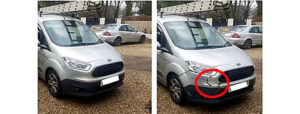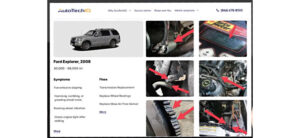Customers might expect a high-touch, world-class experience from large dealerships, luxury brands and the likes of Amazon, but now they can get the same experience from “Joe’s Garage“
It happens to every shop: a customer brings their vehicle in, then opts to wait. They ply themselves with coffee and watch the TV in your waiting area, as you scramble to get the car on the lift, manage your technicians to hopefully free up the most suitable one, and dive into the repair, perhaps with parts on hand or from your local parts supplier. You feel the pressure mount as the customer goes for another cuppa joe.

It’s a common scenario, but one that’s going by the wayside during the pandemic. For all the negatives of COVID-19, the auto aftermarket is opening its eyes to some positive things — such as customers being more prone to leave their vehicle rather than bide their time in the shop, where they may come into close contact with other customers, front desk staff, and a variety of parts vendors coming and going. We’ve always known it’s in their vehicle’s best interest when we can take more time with it; social distancing makes the case for not waiting on-site far more persuasive.
This is one example of how the trend for low or no contact has taken hold on an industry that has largely done things the same way for decades. At the same time, it has highlighted the many alternate ways shops can communicate and better engage their customers — reaping greater loyalty and more revenue as a result.
That line to pick up cars and turn over credit cards late in the afternoon? In many cases that’s gone away in favor of text payments made while the customers are still at work. What shop owner wouldn’t want to get paid sooner?
That discussion about nagging issues that could become perilous down the road? That’s being replaced by digital vehicle inspection (DVI) reports that show clearly what’s going bad — and even all that’s right with the car.
And that conversation to schedule the next oil change, brake work or tire rotation? That’s now something the customer can do on their own at the prompt of a text reminder and link to your shop’s online calendar.
Consumers love dealing with companies and service providers on their mobile devices, and that’s only been accelerated by the virus. Text marketing firm SlickText found that 95 percent of text messages are read within three minutes, and savvy repair shops are taking notice. Additionally, 51 percent of Americans are now using some form of touch-free payment, according to Mastercard. While nothing presently exists to make paying for your auto repair joyful, paying by text — often combined with financing options — can ease the process for customers and free up staff for other things.
Significantly, this new paradigm is helping shops build customer trust, earn repeat business and referrals, and increase Average Repair Orders. They’re starting to read the playbook of Amazon, DoorDash, Uber and just about every other consumer-facing service that has conditioned its customers to expect real-time updates about their order. Even your dentist or doctor will show you X-rays or other diagnostic results so you can make better-informed decisions.
Yet, auto repair has largely remained a “black box event.” Historically, the customer drops off their car in the morning, there’s a phone conversation at some point, then everything goes dark. Even those in the waiting area can’t usually peer out at what’s happening on the lift, and insurers frown upon allowing customers in the repair bay. In our business, consumers have to assume you’re telling them the truth.
So shops that can leverage text messaging, DVIs, and even Zoom one-on-ones between the technician and the customer can go a long way to setting customers’ minds at ease. A photograph of a leaky oil pan or fraying belt while the vehicle is on the lift is far more convincing than any phone call. It’s contact-less in its purest form, as the vehicle owner can get the diagnosis visually on their mobile device, and approve the work. When the job is done, they can pay the same way, then just grab the keys and take their car at their convenience.
You Can’t Over-Communicate
The other benefit of this kind of relationship is that when the customer can see the part being addressed and the work being performed, and even interact with the technician in the bay, it’s more likely they will see the value of the service you’re providing. While nobody likes paying to get their car fixed, shame on the repair shop that makes the customer feel like they’re “paying ransom” to get their car back at the end of the process.
By leveraging technology, you now have the opportunity to spotlight the complexity of the work, to tell the customer that “my skilled service tech was able to identify these issues.” There is no longer any excuse to undervalue the services you provide for what you’re charging.
Similarly, DVIs that reveal wear progress over a period of time can foster customer trust, and set them up both mentally and financially to do the repair when the time comes. It’s a winning recipe in a business that has always struggled to get out from that black box.
Nor has accessibility ever been greater than it is now. Customers might expect a high-touch, world-class experience from large dealerships, luxury brands and the likes of Amazon, but now they can get the same experience from “Joe’s Garage.” I like to call technology the great equalizer because it can give even independent shops a professional polish and the sheen of a progressive, customer-centric company.
While many shops were migrating in this direction already, the pandemic has hastened the trend. Even small, boutique shops realized they needed a strong online presence, and to communicate with customers where they live — on their cell phones. BOLT ON has documented a drastic rise in utilization, to the point that we’re now seeing more than 400,000 images sent from shops to vehicle owners every week, up from 300,000 per week prior to COVID.
A lot of shop owners may say they have great relationships with their customers. But the ones we know that engage customers through text messaging, digital inspections and Zoom have expanded those relationships much more positively than they could’ve done in face-to-face transactions. And anything that removes doubt in the mind of the customer is a good thing.
Just keep the coffee pot full after the pandemic ends.
Mike Risich is founder and CEO of BOLT ON TECHNOLOGY, a leading provider of technology solutions to all sectors of the automotive aftermarket. BOLT ON can be reached at info@boltontechnology.com.





Comments are closed.